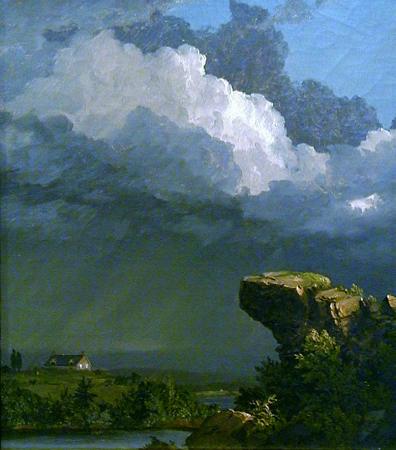Frederic Church (1826 - 1900). Frederic Edwin Church was an American landscape painter born in Hartford, Connecticut. He was a central figure in the Hudson River School of American landscape painters, best known for painting large landscapes, often depicting mountains, waterfalls, and sunsets. Church's paintings put an emphasis on realistic detail, dramatic light, and panoramic views. He debuted some of his major works in single-painting exhibitions to a paying and often enthralled audience in New York City. In his prime, he was one of the most famous painters in the United States. Frederic Edwin Church was a direct descendant of Richard Church, a Puritan pioneer from England who accompanied Thomas Hooker on the original journey through the wilderness from Massachusetts to what would become Hartford, Connecticut. Church was the son of Eliza and Joseph Church. Frederic had two sisters and no surviving brothers. His father was successful in business as a silversmith and jeweler and was a director at several financial firms. The family's wealth allowed Frederic to pursue his interest in art from a very early age. In 1844, aged 18, Church became the pupil of landscape artist Thomas Cole in Catskill, New York after Daniel Wadsworth, a family neighbor and founder of the Wadsworth Athenaeum, introduced the two. Church studied with him for two years; by this time his talent was more than evident. Cole wrote that Church had the finest eye for drawing in the world. During his time with Cole, he travelled around New England and New York to make sketches, visiting East Hampton, Long Island, Catskill Mountain House, The Berkshires, New Haven, and Vermont. His first recorded sale of a painting was in 1846 to Hartford's Wadsworth Athenaeum for $130; it was a pastoral depicting Hooker's journey in 1636. In 1848, he was elected as the youngest Associate of the National Academy of Design and was promoted to full member the following year. He took his own students: William James Stillman in 1848 and Jervis McEntee in 1850. Romanticism was prominent in Britain and France in the early 1800s as a counter-movement to the rationalism of the Age of Enlightenment. Artists of the Romantic period often depicted nature in idealized scenes that depicted the richness and beauty of nature, sometimes with emphasis on its grand scale. This tradition carried on in the works of Church, who idealizes an uninterrupted nature, highlighted by his excruciatingly detailed art. The emphasis on nature is encouraged by low horizontal lines and a preponderance of sky. Church usually hid his brushstrokes so that the painting surface was smooth and the painter's personality seemingly absent. Church was the product of the second generation of the Hudson River School, a movement in American landscape art founded by his teacher Thomas Cole. Both Cole and Church were devout Protestants, and the latter's beliefs played a role in his paintings, especially his early canvases. Hudson River School paintings were characterized by their focus on traditional pastoral settings, especially the Catskill Mountains, and their Romantic qualities. They attempted to capture the wild realism of an unsettled America that was quickly disappearing, and the appreciation of natural beauty. His American frontier landscapes show the expansionist and optimistic outlook of the United States in the mid-nineteenth century. Church differed from Cole in the topics of his paintings: he preferred natural and often majestic scenes over Cole's propensity towards allegory, though Church's work has increasingly been re-examined in terms of themes and meanings. The Prussian explorer and scientist Alexander von Humboldt was a major influence on Church. In his Kosmos, Humboldt put forth a vision of the interconnectedness of science, the natural world, and spiritual concerns. Kosmos, which Church owned, dedicated a chapter to landscape painting; Humboldt gave an important role to the visual artist in scientifically portraying the diversity of nature, especially in the New World. As Charles Darwin's theory of evolution began to overturn Humboldt's ideas of unity in the 1860s, art historians have examined how Church's painting responded to this disruption in Church's world view. The English art critic John Ruskin was another important influence on Church. In Ruskin's Modern Painters, he emphasizes the close observation of nature: the imperative duty of the landscape painter to descend to the lowest details with undiminished attention. Every class of rock, every kind of earth, every form of cloud, must be studied with equal industry, and rendered with equal precision. This attention to detail must be combined with the artist's interpretation, impressions, and imagination to achieve great art.
more...














